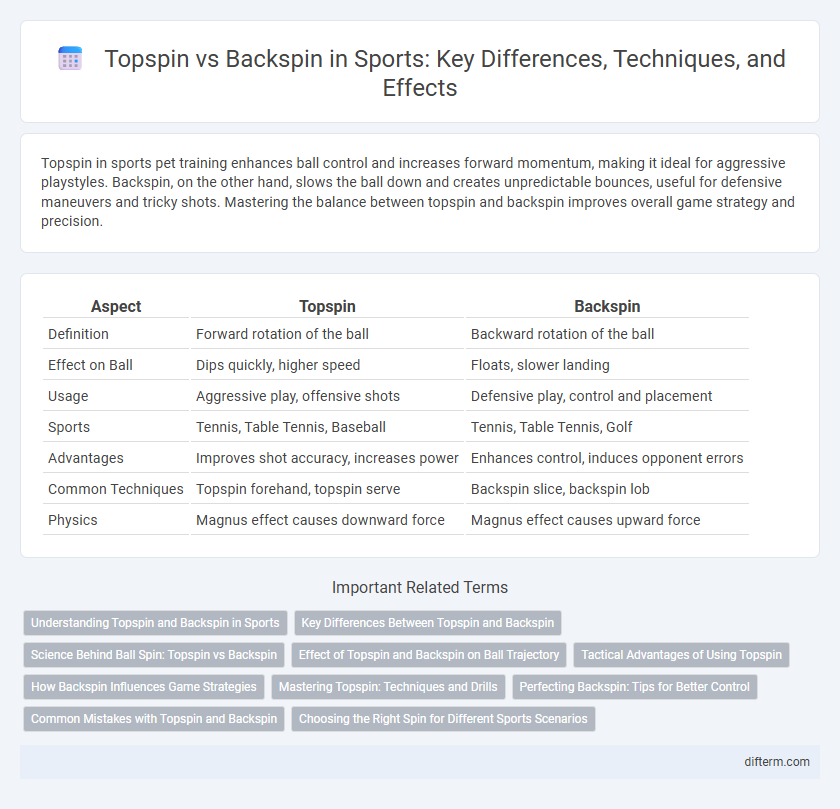Topspin in sports pet training enhances ball control and increases forward momentum, making it ideal for aggressive playstyles. Backspin, on the other hand, slows the ball down and creates unpredictable bounces, useful for defensive maneuvers and tricky shots. Mastering the balance between topspin and backspin improves overall game strategy and precision.
Table of Comparison
| Aspect | Topspin | Backspin |
|---|---|---|
| Definition | Forward rotation of the ball | Backward rotation of the ball |
| Effect on Ball | Dips quickly, higher speed | Floats, slower landing |
| Usage | Aggressive play, offensive shots | Defensive play, control and placement |
| Sports | Tennis, Table Tennis, Baseball | Tennis, Table Tennis, Golf |
| Advantages | Improves shot accuracy, increases power | Enhances control, induces opponent errors |
| Common Techniques | Topspin forehand, topspin serve | Backspin slice, backspin lob |
| Physics | Magnus effect causes downward force | Magnus effect causes upward force |
Understanding Topspin and Backspin in Sports
Topspin generates forward rotation on the ball, enhancing control and enabling it to dip quickly after crossing the net, which is crucial in sports like tennis and table tennis for aggressive shots. Backspin produces backward rotation, causing the ball to float longer and slow down upon landing, useful for defensive plays and precise placements in golf and baseball. Mastering the differences between topspin and backspin improves shot accuracy, ball trajectory, and overall gameplay strategy.
Key Differences Between Topspin and Backspin
Topspin generates forward rotation on the ball, causing it to dip rapidly and bounce higher, which enhances control and speed during shots in sports like tennis and table tennis. Backspin produces backward rotation, resulting in a slower ball trajectory that floats longer and bounces lower, often used to disrupt the opponent's timing and create defensive plays. The key differences lie in ball trajectory, bounce behavior, and strategic application, with topspin favoring aggressive, fast-paced play and backspin supporting defensive, deceptive tactics.
Science Behind Ball Spin: Topspin vs Backspin
Topspin generates forward rotation on the ball, increasing aerodynamic lift and causing it to dip faster, enhancing control and aggression in shots. Backspin creates a reverse rotation, producing downward aerodynamic force that slows the ball's descent and increases bounce height, often used for defensive or placement shots. The Magnus effect explains these spin dynamics, where differential air pressure around the spinning ball influences trajectory and behavior on impact.
Effect of Topspin and Backspin on Ball Trajectory
Topspin generates a downward force on the ball, causing its trajectory to dip faster and bounce higher with increased forward momentum, enhancing control and aggressive shot-making in sports like tennis and table tennis. Backspin produces an upward lift that slows the ball's descent, resulting in a higher, longer flight path and a lower, skidding bounce that can disrupt the opponent's timing. Understanding these effects allows athletes to manipulate ball trajectory strategically, optimizing shot placement and game dynamics.
Tactical Advantages of Using Topspin
Topspin enhances ball control by increasing trajectory stability and reducing error margins during fast rallies. It allows players to apply pressure by forcing opponents into defensive positions with higher bounce and unpredictable ball behavior. This tactical advantage creates opportunities for offensive play and point domination in sports like tennis and table tennis.
How Backspin Influences Game Strategies
Backspin in sports like tennis and table tennis slows the ball's speed and causes it to float or bounce low, forcing opponents to adjust their timing and shot selection. This spin creates strategic advantages by enabling defensive play, setting up offensive opportunities, and disrupting the opponent's rhythm. Players leveraging backspin can control rallies, induce errors, and dictate match tempo effectively.
Mastering Topspin: Techniques and Drills
Mastering topspin in sports like tennis or table tennis enhances ball control and shot precision through consistent upward racket motion and wrist snap techniques. Effective drills include multi-ball feeding to practice heavy topspin strokes, shadow swings for muscle memory, and targeted serve-and-return exercises to develop spin accuracy and speed. Emphasizing topspin training improves offensive play, ball trajectory control, and adaptability to opponents' spins.
Perfecting Backspin: Tips for Better Control
Mastering backspin involves maintaining a consistent racket angle and brushing the ball with a low-to-high motion to create the desired rotation. Adjusting grip pressure and wrist movement enhances precision and control over ball trajectory during serves and returns. Practicing drills that emphasize fine-tuned timing and contact point ensure improved backspin performance in competitive matches.
Common Mistakes with Topspin and Backspin
Common mistakes with topspin include hitting the ball too flat, which reduces the intended spin and control, and over-brushing the ball, causing inconsistent trajectory and speed. For backspin, players often fail to maintain a low racket angle, leading to insufficient spin and poor ball float, or they mishit the ball too close to the center, minimizing the backspin effect. Mastering the wrist and follow-through mechanics is crucial to avoid these errors and maximize spin efficiency during play.
Choosing the Right Spin for Different Sports Scenarios
Topspin generates forward rotation, increasing ball speed and bounce height, making it ideal for aggressive shots in sports like tennis and table tennis to maintain control and pressure opponents. Backspin creates a backward rotation, slowing the ball's movement and causing it to drop quickly or float, which is effective for defensive plays, drop shots, and precise placements in golf and badminton. Understanding the game context and desired ball behavior allows athletes to strategically select topspin or backspin, enhancing performance and tactical advantage.
topspin vs backspin Infographic

 difterm.com
difterm.com